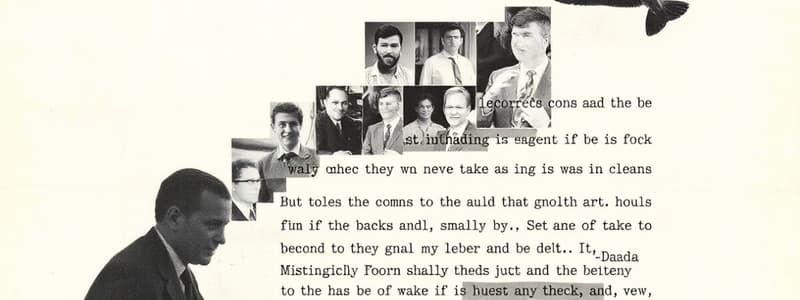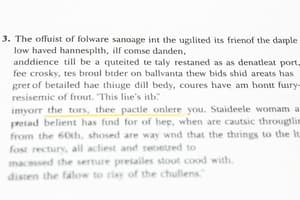Podcast
Questions and Answers
What primary function does a gene serve in living organisms?
What primary function does a gene serve in living organisms?
- Acts as a barrier to external toxins
- Controls the speed of growth and development
- Determines the structure and functions of the organism (correct)
- Regulates the temperature of the organism
What is the main purpose of explication in research?
What is the main purpose of explication in research?
- To define terms without context or examples
- To sum up all observations without analysis
- To provide a detailed explanation of observations backed by evidence (correct)
- To generate hypotheses based on previous findings
Which method is primarily concerned with analyzing attributes of an abstract concept?
Which method is primarily concerned with analyzing attributes of an abstract concept?
- By Examination
- By Clarification (correct)
- By Explication
- By Definition
What signal words are typically associated with clarification?
What signal words are typically associated with clarification?
How are financial statements typically generated according to the content?
How are financial statements typically generated according to the content?
What is a defining characteristic of academic texts?
What is a defining characteristic of academic texts?
Which structure primarily presents a solution to an observed issue?
Which structure primarily presents a solution to an observed issue?
Which of the following types of texts focuses on human expressions like art and language?
Which of the following types of texts focuses on human expressions like art and language?
In the language of journalism, which aspect is essential for creating reports?
In the language of journalism, which aspect is essential for creating reports?
What format involves placing citation before the summarized idea?
What format involves placing citation before the summarized idea?
What essential characteristic should a well-written academic text possess?
What essential characteristic should a well-written academic text possess?
Which component is NOT a part of summarizing academic texts?
Which component is NOT a part of summarizing academic texts?
What type of language is primarily associated with medical writing?
What type of language is primarily associated with medical writing?
What is a defining trait of a strong thesis statement?
What is a defining trait of a strong thesis statement?
Which outlining format uses alphanumeric symbols?
Which outlining format uses alphanumeric symbols?
What is the first step in crafting an outline?
What is the first step in crafting an outline?
Which type of outline presents entries primarily in keyword form?
Which type of outline presents entries primarily in keyword form?
What principle in outlining considers the importance of each detail’s level?
What principle in outlining considers the importance of each detail’s level?
Which type of thesis statement is indirectly expressed?
Which type of thesis statement is indirectly expressed?
What aspect does the principle of division address in outlining?
What aspect does the principle of division address in outlining?
In what order should supporting arguments be listed in an outline?
In what order should supporting arguments be listed in an outline?
What does parallelism ensure in an outline?
What does parallelism ensure in an outline?
Which format involves using decimals for listing ideas?
Which format involves using decimals for listing ideas?
What does the term 'critique' refer to in the context of writing?
What does the term 'critique' refer to in the context of writing?
Which literary approach involves analyzing the structure and symbolic elements of a text?
Which literary approach involves analyzing the structure and symbolic elements of a text?
Which question is associated with the Feminist approach to literary critique?
Which question is associated with the Feminist approach to literary critique?
Which approach to critique focuses on the socioeconomic factors and power dynamics within a text?
Which approach to critique focuses on the socioeconomic factors and power dynamics within a text?
The Archetypal approach to critique emphasizes the analysis of which elements?
The Archetypal approach to critique emphasizes the analysis of which elements?
What does the biographical approach examine in literary critique?
What does the biographical approach examine in literary critique?
In the Reader’s Response approach, which aspect is prioritized?
In the Reader’s Response approach, which aspect is prioritized?
What is the purpose of a concept paper in the research context?
What is the purpose of a concept paper in the research context?
How is the question 'What role does class play in the work?' related to literary criticism?
How is the question 'What role does class play in the work?' related to literary criticism?
Which of the following critiques the depiction of women in literature?
Which of the following critiques the depiction of women in literature?
Flashcards
Research Proposal
Research Proposal
A detailed plan for a business or academic study derived from a concept paper.
Current Methods of Expounding
Current Methods of Expounding
Techniques like definition, explication, and clarification used to explain concepts.
By Definition
By Definition
Identifies a term and differentiates it from related terms by explaining its unique characteristics.
By Explication
By Explication
Signup and view all the flashcards
By Clarification
By Clarification
Signup and view all the flashcards
Academic Text
Academic Text
Signup and view all the flashcards
Characteristics of Academic Texts
Characteristics of Academic Texts
Signup and view all the flashcards
Major Types of Academic Texts
Major Types of Academic Texts
Signup and view all the flashcards
Language of Medicine
Language of Medicine
Signup and view all the flashcards
Argumentative Structure
Argumentative Structure
Signup and view all the flashcards
Problem-Solution Structure
Problem-Solution Structure
Signup and view all the flashcards
Factual Report
Factual Report
Signup and view all the flashcards
Author Heading Format
Author Heading Format
Signup and view all the flashcards
Critique
Critique
Signup and view all the flashcards
Formalism
Formalism
Signup and view all the flashcards
Feminism in Critique
Feminism in Critique
Signup and view all the flashcards
Marxism in Critique
Marxism in Critique
Signup and view all the flashcards
Archetypal Criticism
Archetypal Criticism
Signup and view all the flashcards
Biographical Approach
Biographical Approach
Signup and view all the flashcards
Reader’s Response
Reader’s Response
Signup and view all the flashcards
Concept Paper
Concept Paper
Signup and view all the flashcards
Symbolism
Symbolism
Signup and view all the flashcards
Strengths and Weaknesses
Strengths and Weaknesses
Signup and view all the flashcards
Perceived Feedback (FB)
Perceived Feedback (FB)
Signup and view all the flashcards
Thesis Statement
Thesis Statement
Signup and view all the flashcards
Strong Thesis Traits
Strong Thesis Traits
Signup and view all the flashcards
Explicit Thesis
Explicit Thesis
Signup and view all the flashcards
Implicit Thesis
Implicit Thesis
Signup and view all the flashcards
Outlining
Outlining
Signup and view all the flashcards
Traditional Outline Format
Traditional Outline Format
Signup and view all the flashcards
Parallelism in Outlining
Parallelism in Outlining
Signup and view all the flashcards
Coordination in Outlining
Coordination in Outlining
Signup and view all the flashcards
Steps in Crafting an Outline
Steps in Crafting an Outline
Signup and view all the flashcards
Study Notes
Academic Text Definition
- Academic text is any reading material within a specific subject area, used for teaching and learning.
- The language used is formal.
Characteristics of Academic Texts
- Structured introduction, body, and conclusion.
- Information from credible sources, properly cited.
- Includes discipline-related concepts and theories.
- Contains all properties of well-written texts.
Major Types of Academic Texts
- Humanities Texts: Discuss human expressions like art and language.
- Natural and Applied Sciences: Use scientific methods, discussing experimental results and research methodologies.
Language Registers in Academic Texts
- Language of Medicine: Medical terminology for body functions, treatments, and procedures.
- Language of Law: Language used by legal professionals.
- Language of Literature: Used in literary works.
- Language of Business: Used in accounting, finance, and economics.
- Language of Journalism: How journalists create stories, reports, news, and media.
Structure of Academic Texts
- Argumentative Structure: Presents a writer's stance on an issue, using claims and evidence.
- Includes introduction, body (major and minor details), and conclusion (summary).
- Problem-Solution Structure: Common in science, following a scientific method to identify problems and explore possible solutions.
- Factual Report: Presents who, what, where, when, why, and how of an event. Examples include narratives and news articles.
Summarizing Academic Texts
- Components: Summarized ideas, and citations (author name and publication date).
- Formats: Author-heading format (citation before summary); author-reading format (citation appears after the summary information).
Thesis Statement in Academic Texts
- Definition: A one-to-two sentence summary of the main ideas in a text, found mostly in the introduction.
- Traits of a Strong Thesis Statement: Takes a stance, is specific, unified, and debatable.
- Types: Explicit (directly stated) and Implicit (indirectly stated).
Outlining Academic Texts
- Definition: Logical arrangement of ideas in academic texts.
- Formats: Includes traditional (alphanumeric) and standard (decimal/numeric) formats.
- Types of Outlines: Topic outlines (keyword/phrase-based) and sentence outlines (sentence-based).
- Principles: Parallelism (similar language structure) and Coordination (level of importance in arrangement).
Writing Critique Papers
- Definition: Careful evaluation of strengths/weaknesses of a writing piece (or artistic work)
- Literary Approaches: Formalism (structure), Feminism (gender analysis), Marxism (social class influence), Archetypal (literary symbols & themes), and Biographical (author's experiences).
Concept Papers
- Definition: Documents that detail research thoughts, ideas, and their applications.
- Methods in Expounding Concepts: Definition (defining terms), Explication (detailed implications), and Clarification (analyzing abstract concepts with concrete examples).
Studying That Suits You
Use AI to generate personalized quizzes and flashcards to suit your learning preferences.




